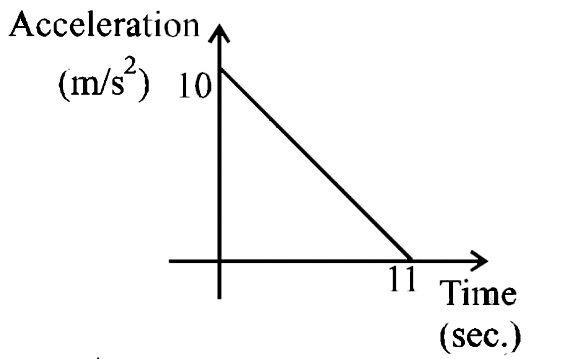If acceleration gradient of a moving body along positive x-axis is −4s−2 and body starts its motion from rest from x=5m, having maximum acceleration (magnitude) then velocity of moving body at x=−3m is
6ms−1
4ms−1
8ms−1
Can't reach at x=−3m
The correct Answer is:C
To find the velocity of the moving body at x=−3m, we can follow these steps:
Step 1: Understand the given information
We are given that the acceleration gradient A is −4x−2. This means the acceleration a can be expressed as:
a=−4x
The body starts from rest at x=5m, which means the initial velocity v0=0.
Step 2: Use the relationship between acceleration, velocity, and position
We can use the formula that relates acceleration, velocity, and position:
a=vdvdx
Substituting the expression for acceleration:
−4x=vdvdx
Step 3: Rearrange and integrate
Rearranging gives:
vdv=−4xdx
Now we integrate both sides. The left side integrates with respect to v and the right side with respect to x:
∫vdv=∫−4xdx
Step 4: Perform the integration
The left side integrates to:
v22
The right side integrates to:
−2x2+C
Thus, we have:
v22=−2x2+C
Step 5: Determine the constant of integration C
To find C, we use the initial condition. At x=5m, v=0:
022=−2(52)+C
0=−50+C⟹C=50
Step 6: Substitute C back into the equation
Now we substitute C back into our equation:
v22=−2x2+50
Step 7: Solve for v2
Multiplying through by 2 gives:
v2=−4x2+100
Step 8: Find the velocity at x=−3m
Now we substitute x=−3m:
v2=−4(−3)2+100
v2=−4(9)+100
v2=−36+100=64
Step 9: Take the square root to find v
Taking the square root gives:
v=√64=8m/s
Final Answer
The velocity of the moving body at x=−3m is 8m/s.
---
We are given that the acceleration gradient A is −4x−2. This means the acceleration a can be expressed as:
a=−4x
The body starts from rest at x=5m, which means the initial velocity v0=0.
We can use the formula that relates acceleration, velocity, and position:
a=vdvdx
Substituting the expression for acceleration:
−4x=vdvdx
Rearranging gives:
vdv=−4xdx
Now we integrate both sides. The left side integrates with respect to v and the right side with respect to x:
∫vdv=∫−4xdx
The left side integrates to:
v22
The right side integrates to:
−2x2+C
Thus, we have:
v22=−2x2+C
To find C, we use the initial condition. At x=5m, v=0:
022=−2(52)+C
0=−50+C⟹C=50
Now we substitute C back into our equation:
v22=−2x2+50
Multiplying through by 2 gives:
v2=−4x2+100
Now we substitute x=−3m:
v2=−4(−3)2+100
v2=−4(9)+100
v2=−36+100=64
Taking the square root gives:
v=√64=8m/s
The velocity of the moving body at x=−3m is 8m/s.
Topper's Solved these Questions
- BOOK - FIITJEECHAPTER - TEST PAPERSEXERCISE - PHYSICS747videos
TEST PAPERS
- BOOK - FIITJEECHAPTER - SIMPLE HARMONIC MOTIONEXERCISE - Assignment Problems (Objective) (Level-II)20videos
SIMPLE HARMONIC MOTION
- BOOK - FIITJEECHAPTER - WORK, ENERGY AND POWER EXERCISE - COMPREHENSIONS ( Comprehension-II)5videos
WORK, ENERGY AND POWER
Similar Questions
Knowledge Check
- Question 1 - Select One
A body starting from rest and moving with uniform acceleration will have
Av∝tBv∝sCv∝tDv∝√t - Question 2 - Select One
A body starts from 20 m/s. If its acceleration is 2m/s2, then velocity of the body after 10 seconds is,-
A40 m/s,B20 m/s,C30 m/s,D10 m/s - Question 3 - Select One or More
A body starts from rest and then moves with uniform acceleration. Then.
AIts displacement is directly proportional to square of timeBIts displacement is inversely proportion to the square of the time.CIt may move along a circle.DIt always moves in a straight line.
A body starting from rest is moving with a uniform acceleration of 8ms2. Then the distance travelled by it in 5th second will be
View SolutionAt time t , the position of a body moving along the x - axis is x=(t3−6t2+9t)m Then, it momentarily comes to rest at
View SolutionThe acceleration a of a body, starting from rest varies with time t following the cquation a= 3t + 4. The velocity of the body at timet =2 s will be
View SolutionA body starting from rest and has uniform acceleration
8m/s2 . The distance travelled by it in5th second will beView SolutionA body starts from rest and moves along a straight line path with uniform acceleration. The ratio of velocities at t = 1s and t = 2 s is ______.
View Solution


